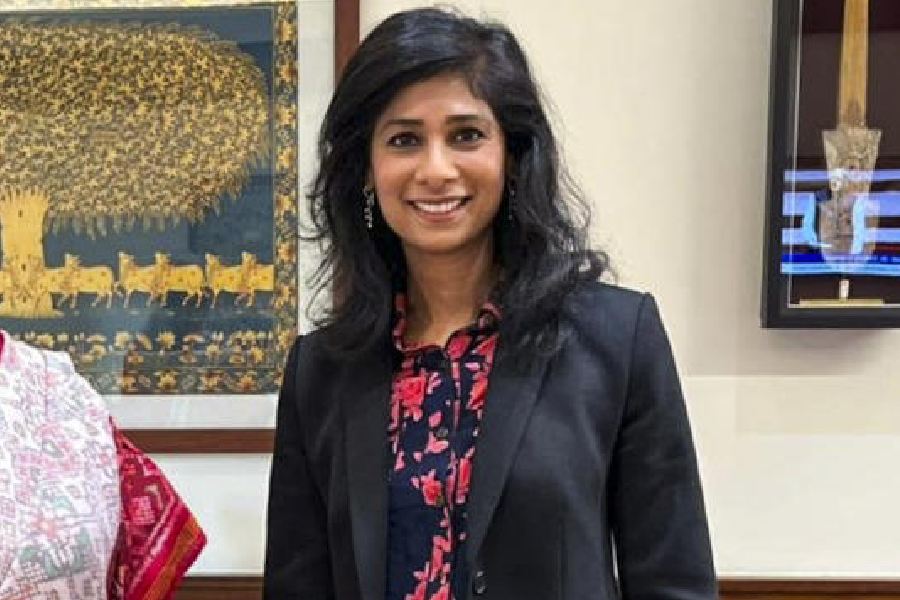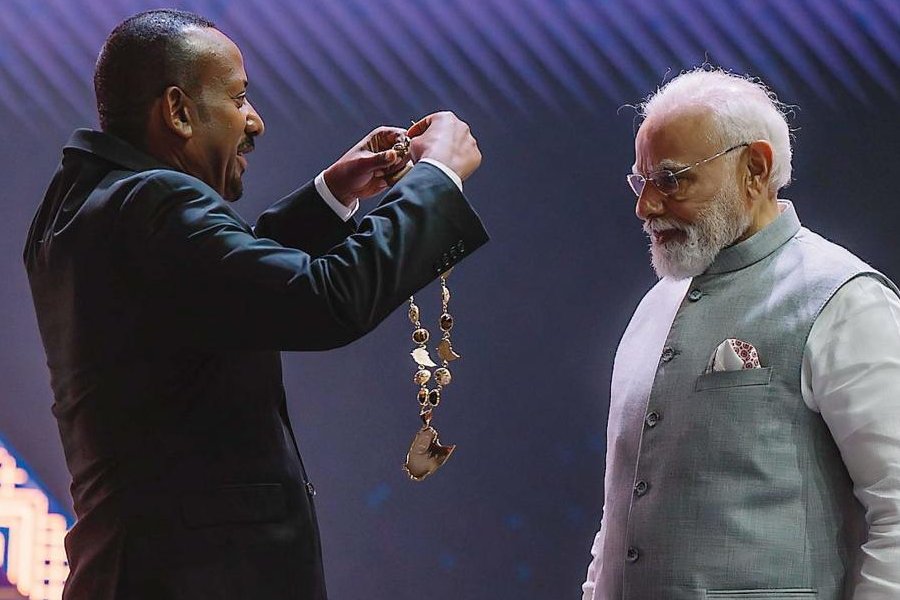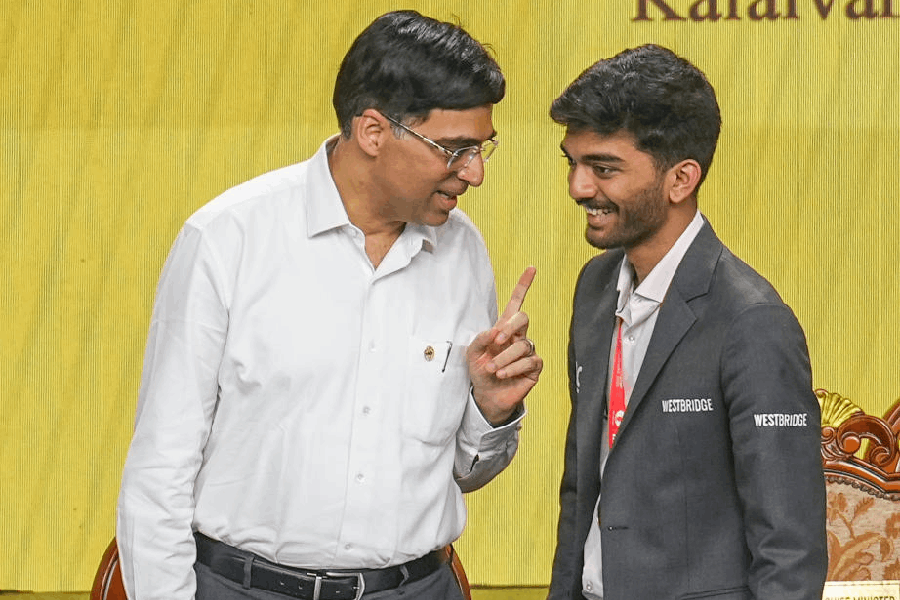 |
| Agreed to disagree: Rabindranath Tagore and Mahatma Gandhi |
The essay is inspired by an argument between the scholar-librarian B.S. Kesavan and his son Mukul that I was once privy to. I forget what they were fighting about. But I recall that the father, then past ninety years of age, was giving as good as he got. At periodic intervals he would turn to me, otherwise a silent spectator, and pointing to his son, say: “Makku!” “Paithyam!” Those were words that Mukul, born in Delhi of a Hindi-speaking mother, did not himself understand. But I did. They meant, roughly and respectively, “imbecile” and “lunatic”.
B.S. Kesavan knew that I lived in Bangalore, that both my parents were Tamil, and that one of my great-uncles had been a Tamil scholar. Thus, when his son’s stupidity (real or alleged) could not be adequately conveyed in their shared language, namely, English, he took recourse to his mother tongue, which was also theoretically mine...
B.S. Kesavan was formidably multilingual. He was fluent in Tamil, Kannada and English, spoke Bengali adequately and Hindi passably, had a good grasp of Sanskrit. No doubt his multilingualism came in handy in his work as the first Indian director of the National Library, his nurturing of a national information system, and his pioneering histories of publishing and printing. His taste for languages was shared by many other Indians of his generation who did not necessarily require those skills in their jobs or careers. My own father, for instance, who was a paper technologist by profession, speaks English and Tamil well, and Kannada and Hindi passably. He also has a reading knowledge of French and German. On the other hand, Mukul Kesavan and I are essentially comfortable in English alone. We can speak Hindi conversationally, and we use documents written in Hindi for research purposes. But we cannot write scholarly books or essays in Hindi. And neither of us can pretend to a third language at all.
***
Let’s move now from the personal to the historical, to an argument on the question of language between two great modern Indians. In the month of April 1921, Mahatma Gandhi launched a broadside against English education. First, in a speech in Orissa, he describes it as an “Unmitigated evil.” Bal Gangadhar Tilak and Rammohan Roy would, said Gandhi, have “‘been far greater men had they not the contagion of English learning”. In Gandhi’s, opinion, these two influential and admired Indians “were so many pigmies who had no hold upon the people compared with Chaitanya, Sanker, Kabir and Nanak.”…
A friend, reading the press reports of this talk in Orissa, asked Gandhi to explain his views further. Writing in his own newspaper, the Mahatma clarified that “it is my considered opinion that English education in the manner it has been given has emasculated the English-educated Indian, it has put a severe strain on the Indian students’ nervous energy, and has made of us imitators.” …
One does not know whether the Mahatma’s anonymous friend was content with this clarification. But someone who was less than satisfied with Gandhi’s views was the poet Rabindranath Tagore. He was travelling in Europe, where he received, by post, copies of Gandhi’s articles. Tagore was dismayed by their general tenor, and by the chastisement of Rammohan Roy in particular. On the 10th of May 1921, he wrote to their common friend C.F. Andrews, saying: ‘I strongly protest against Mahatma Gandhi’s depreciation of such great personalities of modern India as Rammohan Roy in his zeal for declaiming against our modern education.” …
In learning and appreciating English, argued Tagore, Rammohan Roy had merely carried on the good work of Nanak and Kabir… Tagore pointed out that “Rammohan Roy could be perfectly natural in his acceptance of the West, not only because his education had been perfectly Eastern — he had the full inheritance of the Indian wisdom. He was never a school boy of the West, and therefore he had the dignity to be the friend of the West…”
Tagore’s letter to Andrews was released to the press, and read by Gandhi. His answer was to say that he did “not object to English learning as such”, but merely to its being made a fetish, and to its being preferred as a medium of education to the mother tongue.
***
Ramu Gandhi was the son of Mahatma Gandhi’s youngest son, whereas his mother was the daughter of C. Rajagopalachari. In the mid 1950s, when Ramu was entering university, Rajaji took an extended holiday from politics to write modern renditions of the Ramayana and the Mahabharata. He wrote them first in his native Tamil, and then translated them into English.
These modern versions of the epics proved so popular that a demand arose for translations into other languages. Rajaji’s daughter, Lakshmi Devadas Gandhi, volunteered to do them in Hindi, a language she knew well in part due to her long residence in New Delhi. The Hindi versions sold briskly and continuously — they were still selling in the 1960s, and well into the 1970s. Sometimes towards the end of that decade, Mrs Devadas Gandhi decided to make a will. However, as the daughter and daughter-in-law of ascetic and incorruptible politicians, she had no worldly possessions to speak of.
Except, of course, for the royalties from those translations. Who then to will them to? Mrs Gandhi had three sons. The first, Rajmohan was a journalist and author of popular works of biography and history — surely the Fourth Estate and his publishers would take care of him were he ever in distress? The youngest son, Gopal, was a member of the Indian Administrative Service — he would, in time, get a sarkari pension… That left the middle son, the dreamy philosopher who had left six jobs and declined to accept six others.
So it was to Ramu Gandhi that the royalties were willed, and to him, after his mother’s death in 1983, that they came. Every year, without fail, Ramu would get a cheque for several thousand rupees, which would comfortably cover the cumulative bills, for that year, from the IIC bar. And so, in this manner, works originally composed in Sanskrit, then rendered in Tamil and still later translated into Hindi, were to fuel the belly and the mind of the most brilliant man to have walked the lawns or entered the bar or spoken in the auditorium of the India International Centre.
The story may be apocryphal, but it deserves to be true. For, it illustrates like nothing else the beauty and potency of literary bilingualism — practised, in this case, across three successive generations — father, daughter and grandson.










